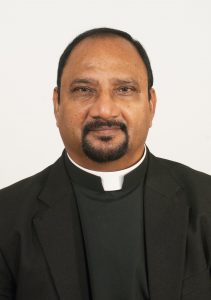 Dear Members and
Dear Members and
Readers,
The theme of the
January-February
issue of the SEDOS
Bulletin is, “Mission
in the Peripheries.”
The theme suggests
that mission is not
simply for those on
the peripheries but is being and working
together with them on a mission, a mission to
bring/spread the “Joy of the Gospel.”
It is not just about reaching the peripheries in
the sense of meeting the flock that is lost and
trying to bring it back by proclaiming the Good
News of hope, happiness and peace. It means
going further by participating in and
experiencing the difficulties people go through
and achieving the mission together. The mission
is not from the outside but of being together.
The fulfilment is in God’s hands.
The peripheries include the poor, the sinners,
the exploited, the homeless, the hopeless and
many others. We missionaries are called to be
like Jesus “who even ate with sinners and tax
collectors.”
Pope Francis reminds us that the Church is
commissioned to “go forth”, but the fact is that
it “stands still.” A good shepherd should know
the smell of the sheep. He takes stock of his
flock by observing the weakest in its midst.
“We know that God works through the
weakest”. And this is the mystery that Pope
Francis is showing us. Like St. Francis he
knows that God walks on the periphery.
In his Address to the Convocation of Catholic
Leaders, which coincided with the Feast-day of
St. Junípero Serra — the great Franciscan, the
spiritual Father of America’s first
evangelization, Most Reverend José H. Gomez,
Archbishop of Los Angeles, said, “St. Junípero
was an immigrant and a missionary, a Spaniard
who came to this land from Spain by way of
Mexico. His witness reminds us — and we
should never forget this — that the mission to
America was a continental mission from the
beginning. It was a mission to make all the
peoples of the Americas, North and South, into
one family — into a new world of faith.”
He recalled Pope Francis’ homily at the
Canonisation of St. Junípero saying, “He is a
model for a Church that adores and worships
Jesus Christ — the Church that answers his call
to follow him. To leave security and comfort
behind and go forth to the ‘peripheries’ of
human experience,” (Convocation of Catholic
Leaders: The Joy of the Gospel in America,
Orlando, Florida, 3 July 2017). The peripheries
were the theme of the short speech that the thenCardinal Bergoglio gave at the meetings before
the Conclave in 2013. “The Church is called to
come out of herself and to go to the peripheries,
not only geographically, but also to the
existential peripheries: the mystery of sin, of
pain, of injustice, of ignorance and indifference
to religion, of intellectual currents, and of all
misery.”
The peripheries, which are growing in the world
today, are the new mission territory. We are
reminded of our mission to the peripheries.
The sadness, the sorrow and all the suffering we
see in our society is rooted in the loss of God, a
loss of the transcendent sense of life. The
answer is Jesus. The answer is conversion. We
need to deepen our love of Christ and our
commitment to His mission.
The final words that Jesus spoke to his
disciples, he continues to speak to us today: “Go
forth! Go out into all the world. Follow me and
walk with me in the power of my Spirit. Bring
all men and women to discover the love that
you have found!”.
The more we try to live like Jesus, the more we
will be drawn to the peripheries, into serving
others. The periphery is the place of encounter
with Christ, and the place of mission.
2
René Stockman, FC, in his article, “Martyr or
Crusader?” explains the two terms with regard
to the faith. According to him the Martyrs,
whose witness to Christ was non-violent, laid
the foundation of the Church. Therefore, as
Christians we retain the mission to proclaim the
faith, by living radically and authentically
ourselves according to the Gospel before
anything else.
The article, “The Poor Embraced by God’s Plan
for Justice and Compassion”, by Joseph Xavier,
SJ, written in two parts, gives us the theological
understanding of the option for the poor. We are
called to care for the poor and marginalised in
society. He says, “Jesus himself taught that
helping the poor is a central aspect of following
him. The early Christian communities were
known for their practice of sharing their
resources and caring for those in need. The
Church continues to prioritise this concern even
today.” According to him, the poor are not just
objects of charity for the wealthy. He tries to reexamine the place of the poor in our
contemporary Christian understanding.
The article, the “Involvement of Divine Word
Missionaries in the Development of Health
Services in Papua New Guinea” by Jerzy
Kuzma, SVD, highlights the healing ministry of
the Divine Word Missionaries in the peripheries
of Papua New Guinea. The author writes, “The
purpose of our missionary life is to bring
fullness of life and God’s goodness to others,
especially by caring for those in need. Since the
beginning of the SVD mission in (Papua) New
Guinea (PNG), serving the sick has been an
integral part of the holistic approach to promote
human development.”
In the article, “The Challenge of Fratelli Tutti to
the Indian Context”, Jacob Kavunkal, SVD,
reminds us that working for the mission in the
peripheries is the mission of all humanity.
Therefore, all must come together as fratelli
tutti. According to him, “The vision of creating
“a single human family” cannot be left to any
one religion (FT, n. 8), but requires the
cooperation of all, as fellow pilgrims.”
Referring to the Indian context, he says, the
“Church has to move away from any
triumphalism and behaviour to become credible
by cooperating with other religions as well as
with the poor and marginalized and, thus, to
decolonize the contours of its theology.”
The article, “Father Damien De Veuster (1840-
1889), A Missionary in and of the Periphery”,
by René Stockman, FC, gives us a concrete
example of Father Damien’s life, who was a
real missionary in peripheries. His missionary
life among the peripheries is a witness for all of
us. He lived as leper with the lepers enthusing
new life into them.
In the last article, “Les Defis Missionnaires….
Dans Le Moments De Capitivite”, Enden, ICM,
shares a real testimony of a missionary living in
captivity. These days we come across many
such incidents in various parts of the world
where the missionaries are taken captives for
the ransom of money as they are the easy
targets. In spite of going through tremendous
tortures and cruelty they find their solace in
God, who protects and strengthens.
I am sure all these articles will inspire each one
of us to become a courageous and daring
missionary, who lives among peripheries and
brings Good News to them.
Dr. John Paul Herman, SVD


